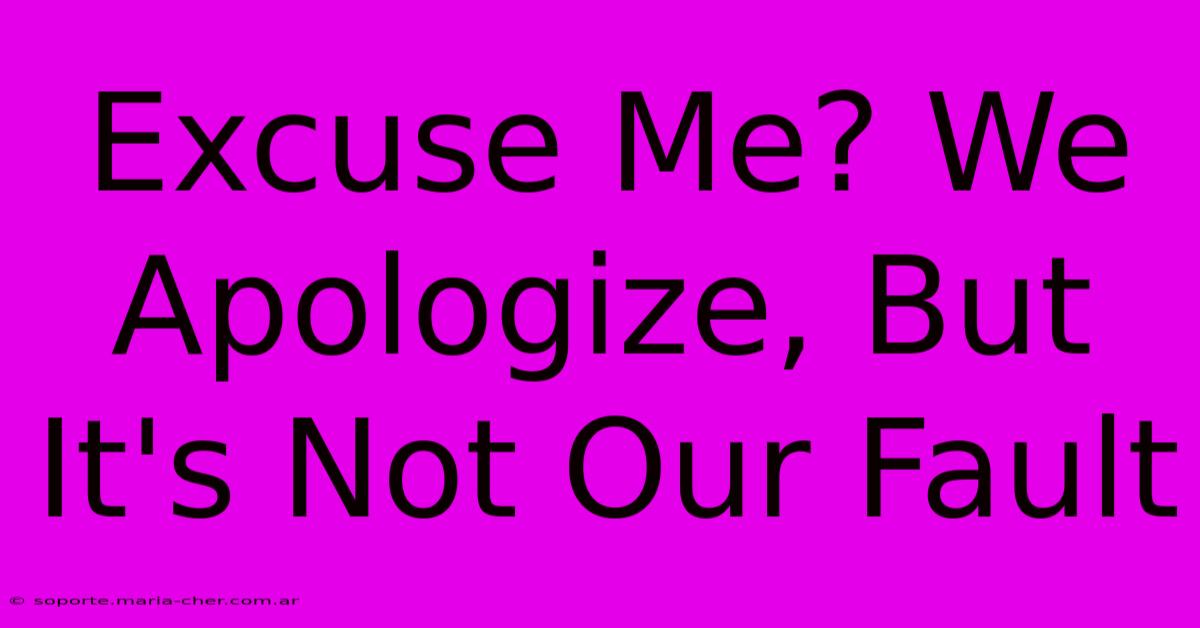Excuse Me? We Apologize, But It's Not Our Fault

Table of Contents
Excuse Me? We Apologize, But It's Not Our Fault: Navigating Customer Complaints When You're Not to Blame
Dealing with unhappy customers is never fun, but it's especially challenging when the problem isn't your fault. Whether it's a supplier issue, a third-party service failure, or a misunderstanding on the customer's part, you still need to handle the situation with grace and professionalism. This article will guide you through the process of addressing customer complaints when you're not at fault, maintaining your reputation and minimizing damage control.
Understanding the Customer's Perspective
Before jumping into solutions, it's crucial to understand why the customer is upset. Even if the problem originates elsewhere, their frustration is real and needs addressing. They likely don't care about the technicalities of who's responsible; they want their problem solved. Empathy is key. Actively listen to their concerns, validate their feelings, and show you care about their experience.
Common Scenarios Where Fault Lies Elsewhere:
- Supplier Issues: Delays in delivery, faulty products received from your supplier.
- Third-Party Service Failures: Problems with shipping carriers, payment processors, or other external services.
- Misunderstandings or Misinterpretations: The customer may have misinterpreted your product description, terms and conditions, or instructions.
- Technical Glitches: Website outages, software bugs, or other technical issues beyond your immediate control.
The Art of the Apology (Without Admitting Guilt)
While you're not responsible for the problem, a sincere apology is vital. This doesn't mean admitting fault, but rather acknowledging the customer's frustration and disappointment. Focus on the impact, not the cause.
Here's how to structure your apology:
- Express empathy: "I understand your frustration with this situation. I'm truly sorry you're experiencing this inconvenience."
- Acknowledge their feelings: "I can only imagine how upsetting this must be."
- Avoid blame: Don't point fingers at suppliers, third parties, or even the customer.
- Focus on the solution: Transition quickly from the apology to explaining the steps you're taking to resolve the issue.
Example: "I'm so sorry you received a damaged product. I understand how disappointing this is, and I want to assure you we're working diligently to resolve this."
Proactive Problem-Solving: Showing, Not Just Telling
Once you've apologized, shift the focus to the solution. Be proactive and transparent in your efforts to resolve the situation. This includes:
- Investigating the root cause: Even if you're not directly at fault, investigate the issue to understand what happened and prevent similar problems in the future.
- Communicating updates: Keep the customer informed about the progress of your investigation and the steps being taken to rectify the situation.
- Offering a suitable solution: This might involve a replacement, refund, discount, or expedited service.
- Documenting everything: Keep detailed records of all communications and actions taken. This is crucial for both customer service and potential future reference.
Turning a Negative into a Positive: Building Customer Loyalty
Handling a complaint effectively, even when you're not at fault, can significantly strengthen your relationship with the customer. When you demonstrate empathy, take ownership of the problem (without accepting blame), and proactively offer solutions, you show customers that you value them and are committed to providing excellent service. This can actually lead to increased customer loyalty and positive word-of-mouth referrals.
Keywords: customer complaint, apology, not my fault, supplier issue, third-party failure, customer service, problem solving, damage control, empathy, proactive, solution, customer loyalty, communication, transparency, investigation, refund, replacement, handling complaints, negative to positive, business reputation.

Thank you for visiting our website wich cover about Excuse Me? We Apologize, But It's Not Our Fault. We hope the information provided has been useful to you. Feel free to contact us if you have any questions or need further assistance. See you next time and dont miss to bookmark.
Featured Posts
-
Unveil The Enigma Of Gold Vermeil Necklaces Pure Luxury Without The Premium
Feb 08, 2025
-
Symbolize Friendship Elevated A Journey Of Grown Up Bracelets
Feb 08, 2025
-
Dont Miss Out 380 Lexington Ave Nycs Best Kept Secrets Exposed
Feb 08, 2025
-
Unlock Mays Marketing Magic 15 Enchanting Newsletter Ideas To Captivate Your Audience
Feb 08, 2025
-
Unleash The Power Of Flyers The Secret Spots That Will Skyrocket Your Reach
Feb 08, 2025
